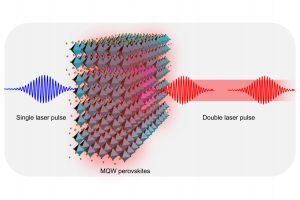A group of doctoral students at the University of Macau (UM) and the Hong Kong Polytechnic University (PolyU) have observed a new phenomenon in metal-halide perovskite optical gain medium, which can lead to the development of ultrashort laser pulse doubling devices. The study has been published in the internationally renowned journal Nature Communications.
Ultrashort laser pulse doubling and manipulating are widely used in many fields, including novel optical spectroscopy, optical communication, as well as imaging and optical signal processing. However, such laser pulse doubling is currently solely realised through bulky external optical instruments, which are not conducive to device integration and miniaturisation. The use of these bulky, external optical setups is inevitable because it is difficult to modify the ultrashort-laser-pulse number through the optical gain medium itself. Therefore, it is imperative to find a new type of optical gain medium that is capable of generating multiple laser pulses with single ultrashort laser pulse excitation. Unfortunately, this kind of gain medium has never been achieved before because of the mandatory requirement of high-efficiency multi-step energy relaxations.
To address this challenge, Ms Guo Jia, Dr Liu Tanghao, and their collaborators in UM’s Institute of Applied Physics and Materials Engineering (IAPME) developed a quasi-two-dimensional metal-halide perovskite quantum wells structure. With single femtosecond laser pulse excitation, they achieved double-pulsed stimulated emission from these quantum wells. By monitoring the carrier dynamics in this new gain material, they found that these unique stimulated emissions originate from two-step high-efficiency carrier funneling from low-dimensional to high-dimensional quantum wells. The discovery allowed the researchers to find a new approach to ultrashort laser pulse multiplication.
The study was led by UM IAPME Assistant Professor Xing Guichuan and PolyU Assistant Professor Li Mingjie. Assistant Professors Hong Guo and Tang Yuxin in the IAPME also made important contributions to the study. The project was jointly funded by the Science and Technology Development Fund, Macau SAR (File no. 091/2017/A2, 014/2017/AMJ), University of Macau (File no. MYRG2018-00148-IAPME), and the National Natural Science Foundation of China (File no. 91733302, 61935017). The research article is available at https://www.nature.com/articles/s41467-020-17096-6
Source: Institute of Applied Physics and Materials Engineering
Media Contact Information:Communications Office, University of Macau
Albee Lei Tel:(853) 88228004Judite Lam Tel:(853) 88228022Email:prs.media@um.edu.moUM Website:www.um.edu.mo

